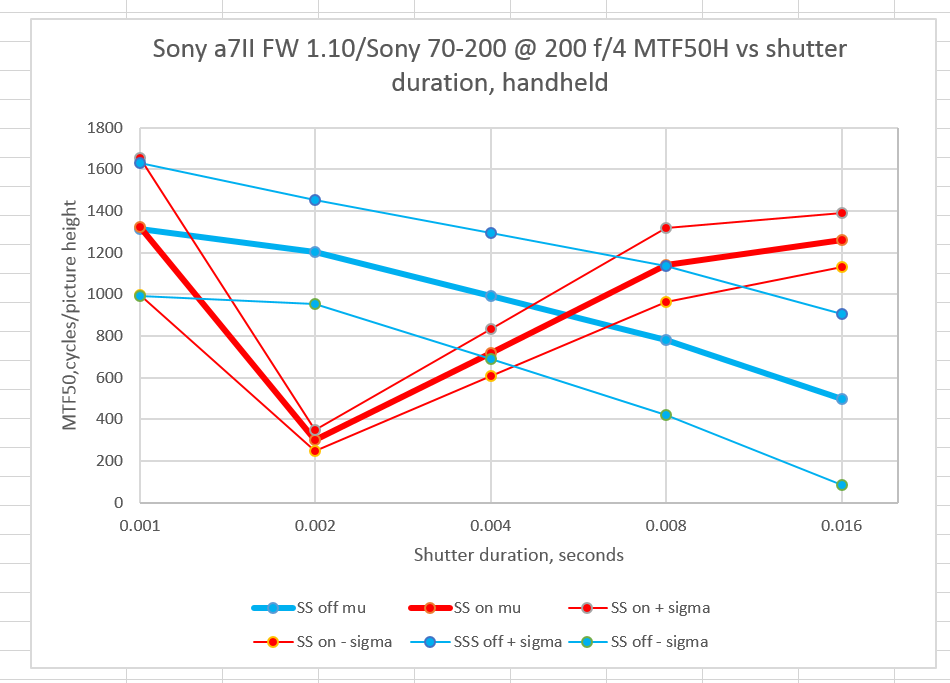In the previous post, I reported on the performance of the Sony 70-200mm f/4 OSS FE lens on the a7R camera, with and without OSS turned on. In this post, I’d like to present similar results for the same lens on the a7II, with and without in-body image stabilization (IBIS), and with electronic first-curtain shutter (EFCS).
Here’s the protocol:
- RRS L-plate on camera base. This is not the usual way to mount the 70-200, which has its own collar mount, but it’s the way I mounted the a7R, and I didn’t want to make a change.
- RRS TVC-34 heavy-duty carbon fiber tripod.
- Arca-Swiss C1 Cube head.
- Landscape orientation.
- Lens zoomed to 200mm.
- No filter.
- The lighting: a single Fotodiox LED-200WA-56 daylight balanced variable-output flood.
- ISO set to 1000, f-stop set to f/8.
- Focusing using single shot autofocus. The focus point is a Siemens star on the target.
- Drive set to single
- EFCS on
- Manual exposure mode.
- Self-timer set to 2 seconds
- OSS set to off. On the a7II, this turns off IBIS.
- Lamp to full, shutter to 1/1000 second, make 16 exposures with new focusing for each, turn the light down a stop, turn the shutter speed down a stop, make 16 exposures… until you get to 1/60 of a second.
- OSS to on. On the a7II, this turns on IBIS.
- Repeat exposure sequence.
- Develop in Lightroom 5.7.1 with standard settings.
- Crop, export as TIFFs, analyze for horizontal edge MTF50 in Imatest.
- Export the results to Excel, crunch the stats, and graph.
The first, tripod mounted results (yes, I know you’re not supposed to turn on IBIS/OSS when the camera is on a tripod):
The bold lines are the average (aka mean, aka mu) values. The lighter lines are the average value plus and minus the standard deviations (aka sigma). If the statistics are Gaussian, about two thirds of the expected results will lie between the two pair of lighter lines. Orange is OSS on, and blue is OSS off.
Even more so than the a7R, if you’ve got a good solid tripod, you don’t absolutely have to heed Sony’s warning to turn off OSS when you mount the camera on a support.
Now let’s do the whole thing again hand held:
Whoa! Something terrible is going on at 1/500 second (0.002 second). I checked the firmware level on the camera. 1.10. I upgraded to 1.20 and re-ran the test:
That makes more sense. The combination of OSS and IBIS (Sony says with an OSS lens mounted to the a7II, the camera will use the OSS for pitch and yaw, and use IBIS for roll, up/down and right/left) helps a tiny bit with the spread but not the mean at 1/1000, helps a bit with the mean at 1/500, helps some with both at 1/250 and 1/125, and really makes a big difference at 1/60.
Note the absolute value differences in the MTF50 scores on the two runs with OSS off. That proves that 16 exposures is not enough to give good solid MTF50 numbers for handheld exposures.
If you’re going to mix OSS and IBIS, update your firmware, folks. I know that Sony doesn’t make it easy, but it does make a difference, at least with the a7II and the 70-200 f/4 lens.



Christer Almqvist says
QUOTE If you’re going to mix OSS and IBIS, update your firmware, folks. UNQUOTE
Easier said than done if your Mac runs on OS X 10.10.2
Jean Pierre says
Many thanks, for the test, Jim!
It is not easy, the combination IBIS and OSS!
It also depends on how I hold the lens forward or behind the lens!
And, have I put my elbows to the body? How is the “tremor” of each individual, strong or weak? Everyone shakes !!!
For telephoto lenses, it is very difficult to shoot a sharp image by hand.
I think a tripod, is the “solution”, when I can not shoot with 1/2000 or higher!
It will take some time until the technicians of Sony has develope a firmware that works perfectly with the combination IBIS and OSS. At the moment it is still in the “try and error phase”.